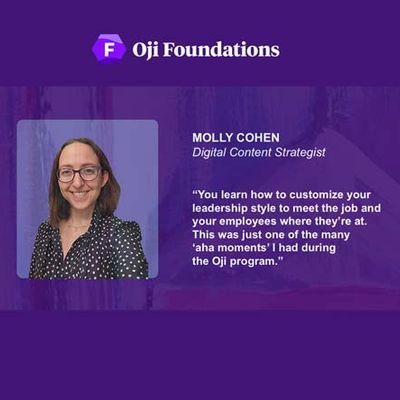Webinar Recap: Mastering Emotional Intelligence Training with J&J and Amazon (Link Included)

Oji Life Lab Co-Founder and Head of Learning Andrea Hoban recently sat down with L&D leaders at Johnson & Johnson and Amazon Web Services to discuss the very different paths each took to make emotional intelligence training a part of their company’s culture.
Kim Bilyeu, Director at Johnson & Johnson, and Rich Hua, Amazon Web Services’ Global Head of EPIC Leadership, offered insights into many important issues surrounding the rollout of EI training, including:
- The value of EI training — and how to communicate that value to colleagues and leaders.
- The reasons an organization will want to bring EI training to their staff.
- How to address internal resistance to an EI training program.
- How to continually monitor, analyze, and improve your organization’s training program.
- When and how to use emotional intelligence assessment tests.
- Ideas and advice for rolling out emotional intelligence training at your organization.
If you want to hear Kim’s and Rich’s valuable insights on all these topics, and learn about their firsthand experiences, you can watch the webinar here: Mastering Emotional Intelligence Training with J&J and Amazon.
But in this post, we’ll focus on that last bullet, and highlight these leaders’ advice for successfully bringing this type of training to your organization.
How to Roll Out EI Training: Tips from Amazon and J&J
1. Identify (and be able to articulate) a genuine organizational need.
Kim, who leads global training for J&J company Biosense Webster, sought out emotional intelligence training in direct response to a business need. Specifically, her company’s sales department had shifted its hiring practices to bring on more recent graduates as opposed to seasoned sales reps.
The results, Kim explains, were that the company saw a dip in sales and revenue — and the sales department attributed this largely to the young new-hires’ lack of skills in interacting with customers and prospects in environments that are already emotionally charged, such as hospitals and operating rooms
When Kim found an emotional intelligence training program, she explains, she was able to present it as a solution to an organizational challenge her entire leadership team already knew they were facing. This made it much easier for Kim to earn the executive buy-in to move ahead with a pilot program to prove the value of EI training.
2. Use your influence (and passion) to build internal support.
Rich Hua began his journey of bringing emotional intelligence training to Amazon simply by offering small talks and workshops to his sales team — where participation was strictly voluntary.
Participation was high. Word got around. And soon Rich was asked to deliver an EI talk at Amazon’s annual global sales conference. Attendance was so strong at that event — standing-room only in a 1,000-seat lecture hall — that executives across the company began asking to have EI training for their business units.
Rich then created an email newsletter for Amazon employees — again, strictly opt-in — where he would deliver interesting emotional-intelligence content he found online. That newsletter has become so popular across Amazon that it now has more than 50,000 subscribers.
Rich’s advice for anyone interested in bringing emotional intelligence learning to their organizations is to begin sharing these skill-building tips and insights using any avenues available — independent of whatever formal EI training the company ultimately decides to roll out.
3. Start small — with a pilot program.
“Just get started,” Kim says. “That’s the best advice I can give. And Rich concurs: “Start small. Start today.”
Kim began her EI training rollout with a relatively small group of participants. As she explains, “You find a cohort of like-minded people in your organization, build a small pilot program with them, and then collect all the data you can to show the value of the program.”
There are several benefits to this approach, Kim notes. First, you’re able to leverage the data you collect to demonstrate improved outcomes — this proof of impact will help you earn approval for a broader rollout. Second, analyzing the results of a small pilot training will allow you to discover what’s working and what isn’t before you build your larger program — so you can make adjustments and continually improve it.
And third, creating a small pilot will make it much easier to get started — something both Kim and Rich say is the most important step.
4. Flip the question from “Why EI training?” to “What outcomes could we improve?”
Finally, Rich offers an interesting idea for building internal interest in emotional intelligence training. Instead of simply making a bulleted list of the benefits of implementing a program, he recommends also approaching the topic from a different perspective.
“Ask the question this way: What business problems could we solve or improve if our people had more empathy or became more aware of their own emotions and the emotions of others?”
As Rich notes, answering those questions will uncover many key business improvements: strengthening customer relationships, becoming better negotiators, improving leadership skills, becoming better team members, etc. Any EI training that helps to facilitate these outcomes would create a significant competitive advantage for an organization.
“As you begin answering that question,” he adds, “it becomes clear the amazing degree to which emotional intelligence skills can contribute to tangible business improvements.”
Looking for more EI insights? Sign up for our People Powered Newsletter
Latest Posts
BACK TO HOME ❯Sign up for our People-Powered Newsletter.

 Meet our Program Experts
Meet our Program Experts
 Why Oji is Different
Why Oji is Different
 First Impressions of the Oji Foundations Program
First Impressions of the Oji Foundations Program